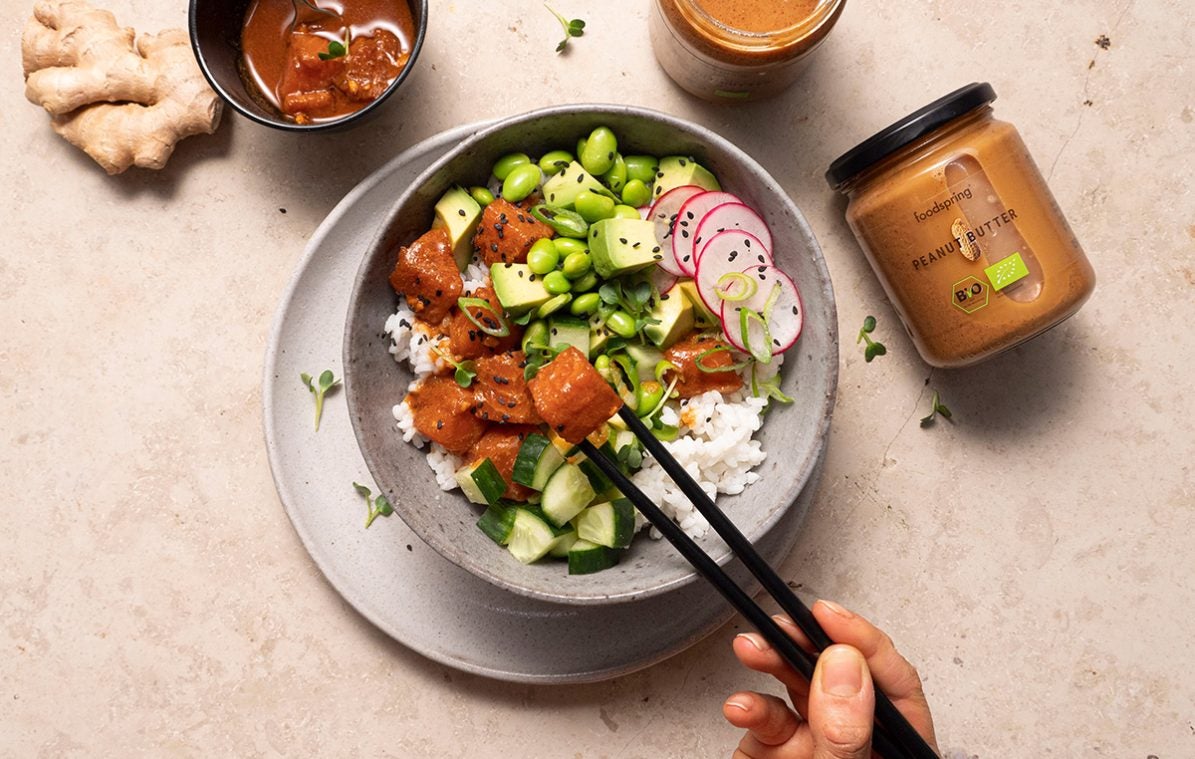12 Surprising Tips On How To Eat More Protein
 ©foodspring
©foodspring
There are many reasons for adding more protein to your diet: Muscle training, weight-loss diets, and even plant-based diets might focus on the protein content of food. But although you’ve made the decision to eat a high-protein diet, it’s not easy to do so on a day-to-day basis, especially if you want to keep your nutrition plan healthy and varied.
Why is variety so important? Wouldn’t eating cottage cheese and lean meat every day be the easiest solution? For many people, this isn’t a good way to eat protein-rich food, if only from a culinary and ecological point of view. Moreover, proteins are made up of different amino acids. Some amino acids, called essential amino acids, are even indispensable for our body, i.e. you have to take them in with your food, since our bodies can’t make them on their own. The best way to do this is to eat a varied mix of protein-rich foods. This way, you supply your body with the entire range of vitamins, minerals, and secondary plant substances. Stocking your pantry is a great first step to make sure you have some options on hand. What always goes into our shopping basket? Our Vegan Protein Bars with extra chocolate. Not only are they vegan, but they’re also a great source of protein for getting a boost in between meals. We show you 12 surprising tips on how to eat more protein.
#1 Tahini
The sesame paste contains a full 17 grams of protein per 100 grams and all essential amino acids. You may already know tahini (sometimes also called tahina or tahini) from hummus recipes, but ground sesame seeds can do much more. You can use it to enhance sauces and dressings, or use it to replace peanut butter in cereal or oatmeal. When buying tahini, look for unhulled sesame seeds, which have a higher fiber content.
#2 Pancakes
Pancakes are simply the best. For breakfast or brunch – or even something savory for lunch or dinner. And they can be surprisingly In most recipes, eggs are added to the batter as a source of protein. With a little extra protein powder, the pancake then finally becomes a protein-rich dish.
#3 Edamame
Unripe soybeans are called edamame. Because just like ripe soybeans, edamame is a good source of vegetable protein, with around 12 grams of protein and only 125 calories per 100 grams. Instead of chips or pretzel sticks, try nibble on edamame on your next movie night. In Japan, they’re even a popular snack in bars. You can also use these legumes in cooking. They’re especially good as a pop of vibrant green in Asian recipes.
#4 Bone broth
Bone broth contains valuable protein, such as collagen, and you can make it from leftovers. The easiest way is to prepare it is to make a large amount at once and pour it into jars or larger containers to store in the fridge or freezer, so you’ll always have bone broth on hand for soups and sauces. In our opinion, it’s definitely a healthier option than store-bought broth and an easy way to add more protein to your diet.
#5 Protein-rich baking
Cakes, cookies, and other baked goods are usually neither particularly healthy nor rich in protein or suitable for weight loss. But you can change that. Use protein powder for baking. You can replace about 30 to 50 percent of the flour with protein. A slice of lemon cake, for example, can provide 10 grams of protein.
#6 Pistachios
Surprisingly, these little green tidbits are a super source of protein. You can add them to your diet as a snack, use them chopped as a topping for salads, or enjoy them as a mush on bread. 100 grams of the seeds contain about 18 grams of protein, but also minerals like iron and potassium, vitamins, and fiber.
#7 Pizza, pasta, and bread
Most traditional baked goods and pastas are high in carbohydrates and low in protein. But that doesn’t mean you have to give up your favorite food. Our Protein Pasta and Protein Pizza are great ways to add more protein to your daily diet. You can also, for example, bake your own Protein Bread with flax seeds, almonds, cottage cheese, and wheat bran. And when in doubt, you can make the topping or sauce protein-rich. You can eat more protein with legumes, tofu, or cottage cheese, for example.
#8 Clever combinations
How well your body can process protein can be increased by combining foods in a sensible way. By the way, this is yet another reason to keep a varied diet if you want to eat more protein. Your body will be happy with the following protein-rich combination:
- Eggs + potatoes
- Milk + Wheat
- Eggs + Soy/Tofu
- Cottage cheese + potatoes
- Soy/Tofu + Rice
#9 Chia seeds
The small seeds from Latin America are rising in popularity around the world. And rightly so: They score with protein, fiber, and omega-3 fatty acids. In addition, chia seeds are quite versatile in the kitchen. They can be eaten as chia pudding, added to smoothies, or used as a topping for vegan banana ice cream.
#10 Spirulina
Spirulina is quite the trendy algae. Even if a large part of its health claims don’t stand up to scientific scrutiny, with 60 percent protein content, it’s still a protein-rich food. It’s best thrown into green smoothies. With a little more research, we’re sure there will be more to say about its potential health benefits in the future.
#11 Hemp seed
Hemp is one of the oldest crops and is currently experiencing a renaissance. Hemp seeds are also becoming more and more popular, because they’re a great source of vegetable protein and a sneaky way to help you eat more protein. You can simply sprinkle the seeds over your food. They’re great as a topping for both sweet and savory dishes.
#12 Insects
For some time now, insects have been described as the protein source of the future, because they’re more climate-friendly than meat and at the same time contain high-quality protein. Products with insects or insect-protein are an integral part of the diet in many parts of the world, and they’re gradually gaining recognition in even more places. So far, however, they’re still a real insider tip for those looking to try something new.
More things to know from foodspring:
- Pistachio—So Much More Than a Superfood
- Pea Protein: The vegan protein source your muscles will love
- Protein Shakes Compared: What really matters
- Plant protein – the best vegan protein sources
Sources for this article
We at foodspring use only high-quality sources, including peer-reviewed studies, to support the facts within our articles. Read our editorial policy to learn more about how we fact-check and keep our content accurate, reliable, and trustworthy.
































